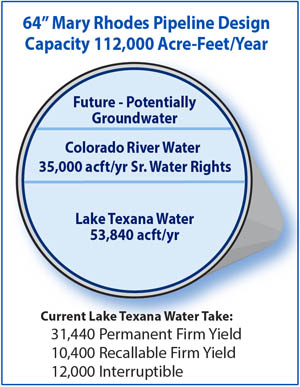October 19, 2013
A major rainfall event in the Nueces River Basin 150 miles west of the Corpus Christi Bay area on October 13th sent a wave of flood waters flowing downstream on the way to Lake Corpus Christi.
Lake Corpus Christi (LCC), which had been holding steady at about 25% of capacity for the past five months, began seeing inflows on October 19th with the major flood wave expected to begin arriving by Oct. 22nd. The lake was last full briefly in 2010.
Inflows from this event have the potential to fill LCC to its capacity of 257,000 acres (compared to 68,000 acre feet in storage on Oct.19th). River flows at Tilden peaked at 36,000 cubic feet per second on Oct. 18th, the third highest crest ever recorded at that location.
The Oct. 13th rain event included in 6 to 8 inches over Dimmit, La Salle and part of Webb County, north of Laredo. Crystal City had almost 14 inches and Carrizo Springs reported 9.6 inches. The heaviest rainfall did not extend eastward into the Frio River watershed upstream from Choke Canyon Reservoir.
On the Nueces River flood flows from the large western watershed were expected to continue into early November.
If inflows result in the complete filling of Lake Corpus Christi it would be a dramatic reversal of water supply storage conditions in the Nueces Basin. As of Oct. 18th the combined storage of Lake Corpus Christi and Choke Canyon Reservoir stood at 32.8% and was threatening to send the region’s water customers into Stage 3 mandatory water restrictions. An overflowing Lake Corpus Christi would push the combined LCC/CCR total to more than 50% of capacity for the first time since June 2012.
TASK FORCE REPORT
A Blue Ribbon Task Force on water supply reported to the Corpus Christi City Council on Oct. 15th, recommending that the region move forward with multiple water supply options.
The task force gave strong support to completion of the Mary Rhodes Pipeline Phase II which will allow delivery of 35,000 acre feet of water per year from the Colorado River to customers in the regional system managed by the City of Corpus Christi. Once completed it will mean that the Corpus Christi area has a more diversified water supply with water coming from the Nueces, Navidad and Colorado river basins.
The task force also recommended that additional capacity in the pipeline be utilized to potentially transport ground water supplies in the future. Without targeting a specific source, the task force recommended pursuing area groundwater supplies and desalination of brackish ground water as possible steps toward drought proofing.
The group concluded that seawater desalination is expensive and that brine concentrate disposal is challenging but that Corpus Christi is a favorable location for it in the future.
Other recommendations included:
>> Be prepared to gear up staffing.
>> Consider new administrative structure with dedicated staff.
>> Involve regional communities and industrial customers.
>> Be prepared to provide additional dedicated funding for project planning and development.








